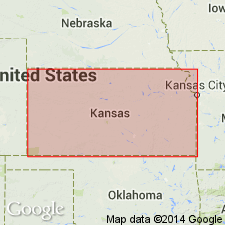
- Usage in publication:
-
- Eureka limestone
- Modifications:
-
- Original reference
- Dominant lithology:
-
- Limestone
- AAPG geologic province:
-
- Cherokee basin
Summary:
Pg. 67, 73. Eureka limestone proposed by G.I. Adams for limestone which serves a protector and assists in production of permanent escarpment extending from madison [in directions described in detail] to south line of State. Overlies what seems to be equivalent of Osage shales [really a higher shale, the Scranton]. Same as Burlingame limestone [older name]. Age is Late Pennsylvanian (Virgil).
Named from Eureka, Greenwood Co., southeastern KS.
Source: US geologic names lexicon (USGS Bull. 896, p. 707); GNC KS-NE Pennsylvanian Corr. Chart, sheet 2, Oct. 1936.

- Usage in publication:
-
- Eureka limestone†
- Modifications:
-
- Abandoned
- AAPG geologic province:
-
- Cherokee basin
Summary:
†Eureka limestone preoccupied. Same as Burlingame limestone, according to R.C. Moore, 1936 (Kansas Geol. Survey Bull., no. 22, p. 215).
Source: US geologic names lexicon (USGS Bull. 896, p. 707); GNC KS-NE Pennsylvanian Corr. Chart, sheet 2, Oct. 1936.
For more information, please contact Nancy Stamm, Geologic Names Committee Secretary.
Asterisk (*) indicates published by U.S. Geological Survey authors.
"No current usage" (†) implies that a name has been abandoned or has fallen into disuse. Former usage and, if known, replacement name given in parentheses ( ).
Slash (/) indicates name conflicts with nomenclatural guidelines (CSN, 1933; ACSN, 1961, 1970; NACSN, 1983, 2005, 2021). May be explained within brackets ([ ]).

